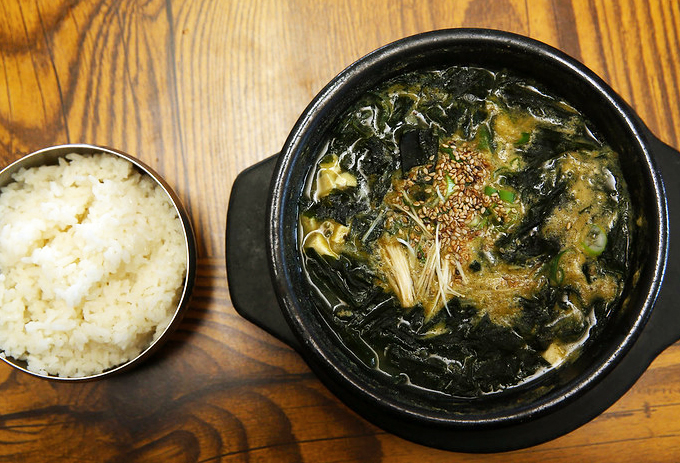- 한국어
- English
- 日本語
- 中文
- العربية
- Español
- Français
- Deutsch
- Pусский
- Tiếng Việt
- Indonesian
By Honorary Reporter Laura Belem Escamilla from Mexico
Photo = Korea.net, Flickr
K-drama lovers have surely often seen in numerous productions the consumption of miyeokguk (seaweed soup) on someone's birthday. How did this custom originate? What are the soup's nutritional properties? I hope to answer these and other questions related to this dish in this article.
A historical record from China's Tang Dynasty said people during Korea's Goryeo Dynasty noticed that whales ate seaweed to recover after giving birth. Thus seaweed was served to women during postnatal care, and its detoxifying function made it ideal for their recovery.
Based on traditional customs, the soup was also dedicated to Samsin Halmoni, the three goddesses of childbirth and destiny in Korean mythology who assists in childbirth and blesses newborns. Koreans in ancient times hoped for a safe birth by placing miyeokguk next to a pregnant woman's pillow on the week before birth, and this is how the dish came to symbolize birth in Korea.
The preparation of this soup is simple, with just dehydrated seaweed, soy sauce, garlic, sesame oil, salt and water needed as ingredients. Throwing in meat or seafood adds protein but beef is the meat of choice, though coastal areas add mussels or white fish. Even with these variations, the seaweed remains the star of the dish.
So is the consumption of miyeokguk during or after pregnancy scientifically proven to be healthy for a pregnancy?
In addition to being the main ingredient, seaweed is the source of the dish's nutritional benefits because women who give birth consume it, mainly during the lactation period, since seaweed is said to be high in calcium and iodine necessary for breastfeeding. Wakame seaweed, which is the most commonly type of seaweed used for this soup, contains about 1,400 mg of calcium per 100 g of seaweed. And as for iodine, the seaweed provides the daily requirement of 150 mcg, so this is not recommended for people with hyperthyroidism.
Seaweed is also rich in fiber, protein, vitamins A, B1, B12, C, D and E, riboflavin, niacin, pantothenic acid and folic acid. As a low-calorie food, miyeokguk has grown popular around the world.

Miyeokguk with rice (Korea.net Flicker)
Wakame seaweed is also high in omega 3, with approximately 180 mg of omega-3 fatty acids per 100 g of food. This nutrient is important during pregnancy and lactation for normal fetal and infant neurological development and adult neurological health.
In addition, women undergoing lactation need more iodine since part of it goes to babies in the form of breast milk. If a mother takes too much or too little iodine, this can affect the concentration of iodine in breast milk and cause thyroid problems in a baby. In Korea, studies have found higher concentrations of iodine in breast milk from women living in rural areas than from those in other countries. So Korea also has cases of hyperthyroidism in babies due to excessive consumption of iodine trough breastfeeding.
So is the tradition of consuming seaweed during lactation harmful? No. Like everything with food, everything should be in moderation. Mothers need iodine when lactating but should consume the proper amount.
Finally, the Korean tradition of eating seaweed soup on a birthday stems from the country's history of childbearing, being a way of honoring mothers who brought people into the world with love and sacrifice.
enny0611@korea.net
*This article is written by a Korea.net Honorary Reporter. Our group of Honorary Reporters are from all around the world, and they share with Korea.net their love and passion for all things Korean.